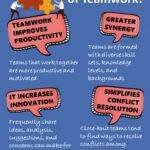
How to Build Collaborative Teams
Build collaborative teams can improve the way your group operates by making the most of each person’s strengths to achieve common goals. The team collaboration doesn’t just happen.
Before you can enjoy the benefits of team collaboration at work, you need to build collaborative teams. This is an ongoing process that requires constant work from team members and managers.
These tips help you create and maintain the collaborative environment you want.
Value the diversity of people
People from different backgrounds and with varying skills can complement one another and give the team all the components it needs for success. If everyone has the same ideas and thought processes, you won’t get many fresh ideas from the group.
Create a group culture that not only accepts but also celebrates diversity to encourage participation and collaboration.
Peolple should be open-minded and ready to listen to their peers. They should feel confident in sharing their own ideas and debating to come to the best group decisions.
Your team members should understand how to communicate well and be able to accept constructive feedback.
Create a collaborative culture
The overall corporate culture and smaller team culture impact how well your teams work together. Establish the expectation of collaboration at work from the top.
Ensure your leadership teams embrace collaboration and support collaborative efforts. Evaluate your current culture to determine how well it fits the idea of teams working together and identify changes you can make to improve it.
Encourage relationship building
Getting to know one another through workplace icebreakers can help improve communication and develop relationships.
You can also build relationships by encouraging teams to bond outside of work. An after-hours happy hour or fun event like mini-golf can help. While it’s ideal to have all team members participate, forcing them can make these extra events seem less appealing.
When done well, team-building activities let your employees learn more about one another, which helps them understand how to interact with one another on team projects.
Have a shared vision and goal
Establishing a clear vision for the team creates a unified experience and something to work toward together. It gives the team a rallying point, with everyone joining together to accomplish that goal.
Understanding how the team works within the larger organizational goals can also motivate the team members to collaborate to help fulfill those purposes.
Capitalize on individual strengths
When you think of teamwork, you often group everyone together as a whole, but looking at the individuals is also important. Every team member brings their own strengths and talents, which should be maximized to get the most out of the team.
For instance, one team member might be very creative and good with design. That person can handle the design aspects of the project. Another might excel in communicating with clients, so they become the primary point of contact for the client.
Someone else might be perfectly suited to keeping the team organized and on schedule. Learning where each team member excels and assigning them related tasks can help the team work as efficiently as possible.
It’s also important to let people try new things. Allowing employees to try new tasks helps them grow and keeps them happy.
Encourage innovative ideas
A collaborative team is better able to reach its full potential when you encourage fresh ideas. Innovation can push the team to come up with new ideas to solve problems creatively.
Give your collaborative teams the room to be innovative without micromanaging. Creating a culture of trust makes it easier for team members to share their creative ideas because they know they won’t be mocked or ignored.
Prioritize communication
At the heart of every collaborative team is strong communication. If your team isn’t communicating regularly or there’s miscommunication, it’s nearly impossible to work well together.
Poor communication can also keep team members from speaking up and sharing their ideas. Having everyone contribute makes the team stronger and helps you look at situations from different angles.
If communication is an issue, set expectations for the type, frequency and method of communication team members need to use.
Highlight successful collaboration
Don’t let good team collaboration go unnoticed. Celebrating successful collaboration encourages people to continue working that way.
People want to be recognized for doing their job well. Give your teams positive feedback in the moment when you notice good collaboration.
Sharing the praise on a wider scale, such as a company-wide email or at a meeting, gives those involved the recognition they deserve and encourages others to strive for better collaboration.
(Reference: https://www.indeed.com/hire/c/info/how-to-build-and-maintain-collaborative-teams)


